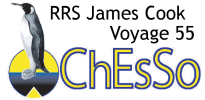Monday 24th January
Today's contributor: Jon Copley
We've been towing our SHRIMP camera system over Hook Ridge for the past 24 hours, with our regular cycle of six-hour watches keeping vigil in the control centre.
For me, this is the thrill of exploration: seeing the landscape and inhabitants of this particular part of our world for the first time in human history. You never know what is waiting to be discovered just over the next rise.
Mapping the distribution of marine life from video surveys is the main project aboard for my PhD student Leigh and me, so we have been taking turns to keep watch throughout the whole dive. For today's diary entry, here are some blow-by-blow excerpts from our log so far:
1135h Depth 550 m: chains of salps, with bodies like strings of glass balls, are now drifting past the camera during our descent to the seafloor.
0008h First sight of the seafloor, at depth 1390 m: a muddy slope stretching away from the view of our cameras, dotted with pale mauve brittlestars holding their coin-shaped bodies just above the sediment with their thin arms.
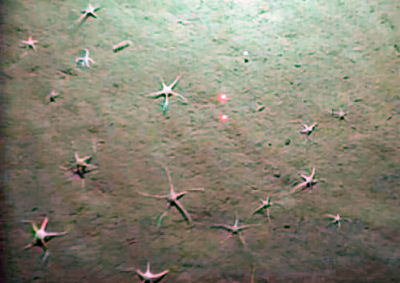
0107h We've seen several orange and white enteropneusts, which leave tell-tale meandering trails behind them as they sweep across the seafloor.
0209h Magnificent Umbellula sea pen - its stalk must be nearly 2 metres long, topped by a crown of red-brown polyps.
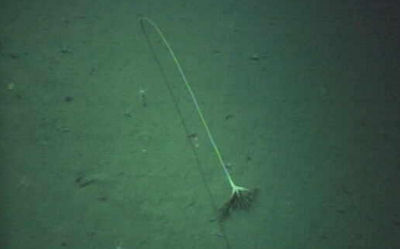
0515h Finished the second of our 1200 metre-long survey lines across the slopes of Hook Ridge; now moving the ship 200 metres up the slope to start our next line.
0630h Rocky terrain now: cliffs of basalt adorned with yellow-stalked, reddish-tentacled anemones. There are also solitary corals, whose stony skeletons look like miniature white trumpets attached to the rock faces.
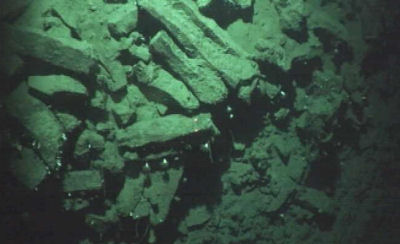
1212h Dropping down a cliff of basalt pillars, rather like those of the Giant's Causeway, into the crater-like feature at the top of Hook Ridge. Depth here is 1190 metres.
1346h Passing over a bed of Anthomastus-type soft corals, whose large yellowish polyps project in all directions from its spherical central body. The floor of the crater so far has been covered in drifts of sediment, punctuated by outcrops of basalt rock.
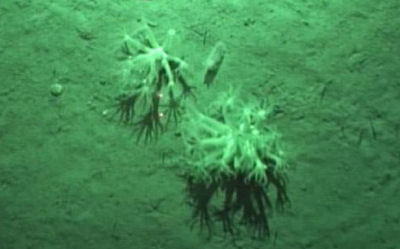
1406h Rich echinoderm fauna here: the seabed is teeming with 8-armed starfish, brown "irregular" sea urchins, more brittlestars, and at least three types of sea cucumber.
1518h A delicate pyncogonid sea spider, around 20 cm across, picking its way around a rock on its slender legs.
1535h Jubilation in the control centre as we catch sight of whale bones on the seafloor. We have stumbled across the backbone and skull of perhaps a minke whale, laid out almost like a museum exhibit. We have marked the location in the nav computer, and are now reversing the ship to see if we can swing SHRIMP back over it again. Is this skeleton supporting a colony of "zombie worms", related to those we found on another skeleton near the South Sandwich Islands last year?
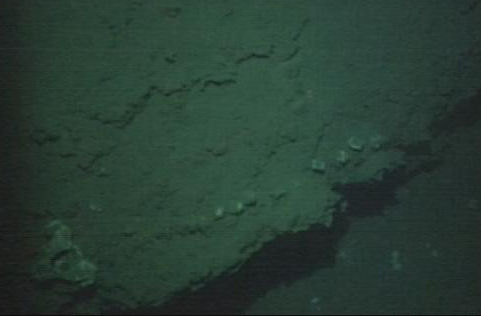
1656h Video screens plunged into darkness as SHRIMP's lights cut out; Russ on winch control quickly pulls the vehicle clear of the seafloor, while James reboots the lighting system. Within a few minutes, we're back in business, and resume our survey line.
1731h We've found a small, castle-like cluster of white mineral spires - about a metre high overall - sticking up from the surrounding greenish-tinged sediments. Shimmering water rises from their peaks.
0022h Lots of small, round burrows on the seafloor here - but no clear sign yet of what makes them.
